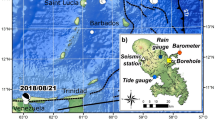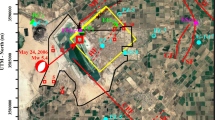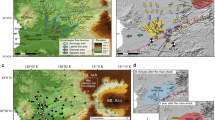Abstract
Active faults are commonly associated with spatially anomalously high concentrations of soil gases such as carbon dioxide and Rn, suggesting that they are crustal discontinuities with a relatively high vertical permeability through which crustal and subcrustal gases may preferably escape towards the earth's surface. Many earthquake-related hydrologic and geochemical temporal changes have been recorded, mostly along active faults especially at fault intersections, since the 1960s. The reality of such changes is gradually ascertained and their features well delineated and fairly understood. Some coseismic changes recorded in ``near field'' are rather consistent with poroelastic dislocation models of earthquake sources, whereas others are attributable to near-surface permeability enhancement. In addition, coseismic (and postseismic) changes were recorded for many moderate to large earthquakes at certain relatively few ``sensitive sites'' at epicentral distances too large (larger for larger earthquakes, up to 1000 km or more for magnitude 8) to be explained by the poroelastic models. They are probably triggered by seismic shaking. The sensitivity of different sites can be greatly different, even when separated only by meters. The sensitive sites are usually located on or near active faults, especially their intersections and bends, and characterized by some near-critical hydrologic or geochemical condition (e.g., permeability that can be greatly increased by a relatively small seismic shaking or stress increase). Coseismic changes recorded for different earthquakes at a sensitive site are usually similar, regardless of the earthquakes' location and focal mechanism. The sensitivity of a sensitive site may change with time. Also pre-earthquake changes were observed hours to years before some destructive earthquakes at certain sensitive sites, some at large epicentral distances, although these changes are relatively few and less certain. Both long-distance coseismic and preseismic changes call for more realistic models than simple elastic dislocation for explanation. Such models should take into consideration the heterogeneity of the crust where stress is concentrated at certain weak points (sensitive sites) along active faults such that the stress condition is near a critical level prior to the occurrence of the corresponding earthquakes. To explain the preseismic changes, the models should also assume a broad-scaled episodically increasing strain field.
Similar content being viewed by others
Author information
Authors and Affiliations
Rights and permissions
About this article
Cite this article
King, CY., Zhang, W. & Zhang, Z. Earthquake-induced Groundwater and Gas Changes. Pure appl. geophys. 163, 633–645 (2006). https://doi.org/10.1007/s00024-006-0049-7
Received:
Revised:
Accepted:
Issue Date:
DOI: https://doi.org/10.1007/s00024-006-0049-7




